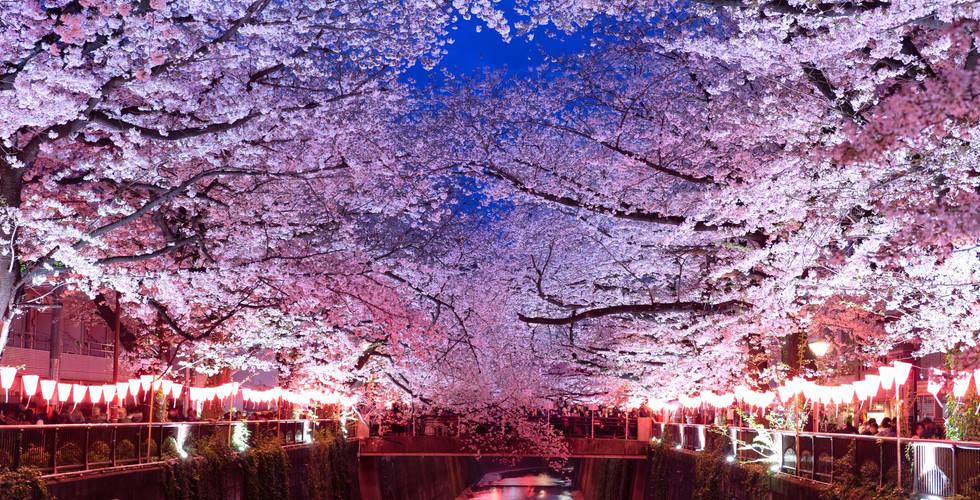What is Hanami? The Past and Present of Sakura in Japanese Culture
Updated: Apr 30, 2024
Japan's cherry blossoms, also known as "sakura," are a rare and enchanting sight that only lasts roughly two weeks. However, sakura's arrival changes the atmosphere of the country with a wave of anticipation and celebration. As spring approaches, news outlets forecast the blossoming and peak bloom periods while music programs play songs with cherry blossom themes. The streets come alive with accessories and culinary delights inspired by the iconic Sakura motif.

When the flowers reach full splendor, many Japanese people pilgrimage to famous cherry blossom viewing spots with their families and colleagues. This annual ritual has become a cornerstone of Japanese culture. But what is the reason behind the Japanese's profound affection for Sakura? Let's delve into the essence of this cultural phenomenon, exploring the roots of Japan's enduring love affair with cherry blossoms and looking at some lesser-known Sakura-related activities.
The Roots of Hanami: Evolution of Flower Viewing in Japan
The blooming of sakura is closely related to temperature, with their petals unfolding as the weather gets warmer. During the Yayoi period (c. 300 BC–c 250 CE), sakura's full bloom served as a signal to plant rice. However, enjoying the blossoms only began with the Nara period (710-794 CE), when China influenced Japanese culture.
During these days, the mainstream flower was the plum blossom, unlike today, where cherry blossoms are the most popular. This was because cherry blossoms were considered sacred trees and objects of faith. They were worshipped as the dwelling place of the god of grain.

The sweet aroma of plum blossoms or “ume” gained immense popularity among the upper class, which led to the tradition of admiring them. The Manyoshu, the oldest existing collection of Japanese poetry, has many poems about the hanami. Interestingly, while only 43 poems were dedicated to cherry blossoms, 110 poems were written about plum blossoms.
During the Heian period from 794 to 1185, Japan shifted from viewing plum blossoms to cherry blossoms. According to the "Nihon Koki," an official Japanese history text, Emperor Saga held Japan's first hanami (cherry blossom viewing) event in 812. This event marked the beginning of an annual celebration of Hanami that the emperor hosted.
The Development of the Hanami Tradition
As time passed, flower viewing became popular among the aristocracy, and the modern hanami tradition began. Even samurai started participating in flower viewing, which evolved into gatherings beneath sakura trees. These celebrations stretched over multiple days, including daily tea ceremonies, poetry readings, and Noh performances. Initially, flower viewing was reserved only for the upper class, but during the Edo period (1603-1867), hanami became accessible to ordinary people.

One of the main factors in making hanami popular among the general population was the deliberate planting of sakura along the Sumida River in Tokyo as a flood prevention measure. At that time, the Sumida River was prone to overflowing due to heavy rains, causing damage to rural areas. However, building a levee was too expensive, so the shogunate proposed planting cherry trees along the river. As a result, many people began to gather under the cherry trees, and the culture of cherry blossom viewing spread among the common folk.
Hanami in Modern Japan
The age-old Japanese tradition still thrives, blending cherry blossoms' classic charm with everyday life's modern vibrancy. Although the essence of the hanami still revolves around appreciating the beauty of nature and its fleeting cherry blossoms, the way people celebrate it has evolved to keep up with the changing times. With many cities partaking in hanami festivals, it's easy finding cherry blossoms in Japan beyond Tokyo.
Sakura x Illumination
The appreciation for cherry blossoms has taken on a modern twist in recent years. Many rural areas started hosting illuminations, transforming the sakura-lined streets into enchanting experiences at night. These stunning displays move beyond the traditional picnic-style celebrations and have become a new and innovative way to celebrate the beauty of these delicate flowers.
The beauty of cherry blossoms in the daytime is undeniable, but the nighttime illumination truly mesmerizes visitors, creating a surreal atmosphere that transports them to a different world. The interplay of light and shadows enhances the beauty of spring, turning many rural areas in Japan, such as Tohoku, into a magical destination for all who seek the allure of sakura after sunset.
Sakura x Sauna
Spring is a time of renewal and rejuvenation. What better way to immerse oneself in the season's beauty than by relaxing in a luxurious tent sauna nestled under blooming cherry trees? This modern take on the traditional practice of appreciating cherry blossoms highlights Japan's ability to blend old and new seamlessly.
Embark on an exciting adventure to the northern parts of Japan, where you can witness the unique and unforgettable sight of the Sakura. Due to the cooler climate, the sakura blossoms later than usual in these regions, providing a stunning and distinct backdrop for your journey. Although it can be chilly in late April, enjoy the warmth of a sauna, which will be a delightful contrast to the crisp air.
Additionally, you can take a refreshing dip in the nearby lake and immerse yourself in the breathtaking scenery. The crystal-clear water of the lake, surrounded by blooming cherry trees, adds to the overall sensory experience. The tranquility of the surroundings will leave you feeling refreshed and revitalized, ready to take on another day of exploring the wonders of nature in Japan.
Sakura x Sweets
When we think about cherry blossoms, we often have the poetic image of enjoying delicious sweets during flower viewing. The tradition of eating sweets during hanami dates back to the "Daigo no Hanami" held in 1598. Various specialty products and sweet treats from all over the country were gathered and shared during this event, contributing to the popularization of eating sweets during hanami.

Nowadays, many restaurants and hotels all around Japan offer different sakura-themed tea sets. Each set is meticulously curated to capture the delicate charm of cherry blossoms. They often come with exclusive sakura-flavored sweets, which combine cherry blossoms' floral essence with tea's comforting warmth. The result is a sensory journey that perfectly embodies the spirit of spring in every sip.
Although cafes in Tokyo and other big cities are often packed with people eager to try limited-time sweets, venturing out to a rural area or staying at a hotel recommended by Untold Japan can provide an opportunity to appreciate the sakura sweets in peace, free from any distractions or disturbances.
Planning Your Hanami Adventure
Sakura is more than just a pretty flower. It represents hope, renewal, and the impermanence of life. By exploring its cultural and historical significance, we can gain a deeper appreciation for the everlasting charm of Sakura. With the assistance of experts from Untold Japan, you can fully immerse yourself in the beauty of Sakura and discover the magic of this timeless floral wonder. So, why wait? Start planning your Sakura adventure today with us!


















댓글